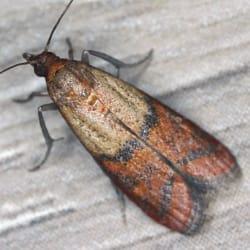Moths have a bad reputation in Hartford, CT. While these fuzzy insects often keep to themselves, certain moths cause problems in Hartford homes, infesting food supplies and growing their populations.
One such moth is the Indian Meal Moth, also known as the pantry moth. Pantry moths are a big problem in Hartford homes, and if you think a moth has started its family in your home, you need to act fast to remove them. Whether you’re looking to identify or remove the moths in your home, learn all about these pests below.
Indian Meal Moth Identification
Indian Meal Moths are common invaders of Hartford pantries. They share many similarities with other moths, but a few key traits make the Pantry Moth stand out in the crowd.
- Like other moths, Indian Meal Moths have oval-shaped bodies and fuzzy wings. They are primarily active at night, fly in a zigzag pattern, and are attracted to food and light. Indian Meal Moths typically grow to be around ½ an inch in length, not including their 6 long legs and 2 short antennae.
- The easiest way to identify the Pantry Moth is by its unique wings. Pantry Moths have bi-colored wings; the front half is a cream color, and the back half is a darker bronze.
- Finally, Indian Meal Moth larvae leave silken webs in the food they eat. These webs are a byproduct of larval feeding and they can cause you to have to throw away food.
Are Indian Meal Moths Dangerous?
As adults, Indian meal moths are not dangerous. In fact, they don’t even eat your food. Adult pantry moths only seek to reproduce, and they do so by laying their eggs into a potential food supply for their young. It’s those larvae that cause the main problems associated with Indian meal moths. Once the larvae hatch and start eating your food supply, your food is contaminated with the saliva, feces, and silk these larvae produce.
Because moth larvae are so small, you might not even realize you have a problem until it’s too late. The unfortunate victims of pantry moths often ingest the eggs or excrement of these moths before realizing there’s a problem, which is why pantry moth prevention is key.
Indian Meal Moth Prevention Guide
Indian meal moths get into your Hartford home primarily by nesting in dry goods. Once these goods are brought inside, they will lay their eggs and disappear. The best way to prevent a pantry moth problem is to keep them from coming indoors, and you can accomplish this through the following tips.
- Examine your dry goods. Pantry moths most often camp out in dry foods like flour, cereal, nuts, and occasionally fruits or vegetables. Always check for moths or eggs in the dry goods you purchase.
- Seal your masonry. Occasionally, Pantry Moths will fly inside from the cracks in your home’s exterior, especially through windows and door frames. Seal these areas accordingly; adult moths often rest on window sills before laying eggs in your pantry.
- Proper food storage. Make it so that, if moths get inside, they can’t get into your pantry. Keep all of your food stored securely with no opportunity for pests to move in.
- Clean all food. Never let spilled food sit for long, and don’t let dirty dishes pile up. The Indian meal moth will try to lay eggs anywhere it can, including in the scraps of food left outside.
If Indian meal moths are causing problems in your Hartford home, let your local pest control professionals handle it. Reach out to the pest control team at American Pest Solutions and take your pantry back from these dirty pests.

